K67A Smartwatch Review
A rugged smartwatch built for outdoor activities with exceptional battery life.

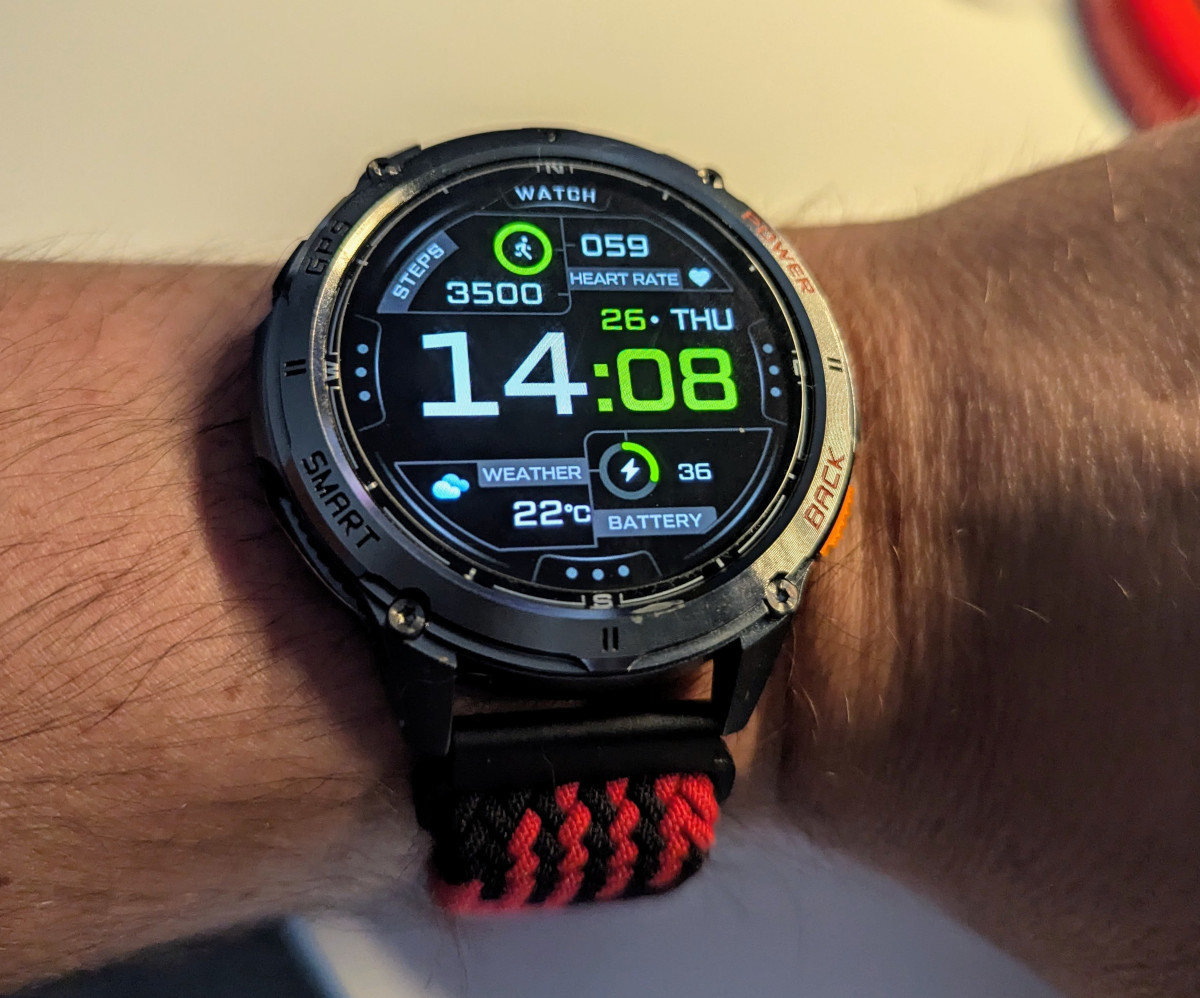
✓ Pros
- 7 day heavy use battery life
- Excellent build quality
- Lovely, pin-sharp AMOLED screen
- Really good value for the price
- When HR sensor is not playing up, activity tracking and calorie burns are superb
- Reliable GPS activity tracking
- Featureful watch OS
- Really useful LED torch
✗ Cons
- Buggy heart rate monitoring
- Limited water resistance
- Configurable button cannot be configured to directly turn on and off the torch
Specifications
- Approximate price (July 2025)
- £30 / $41 / €35
- Display
- 1.43-inch AMOLED, 466x466, 600 nits
- App
- GloryFitPro
- Processor
- Actions ATS3085L
- Heart rate sensor
- VC30F-S
- SpO2 sensor
- VC30F-S
- Accelerometer
- STK8321
- GPS
- L1 single band. GPS, GLONASS, Big Dipper, Galileo, QZSS
- Battery
- 530mAh (5-7 days battery life, 30 days on standby)
- Water Resistance
- IP68
- Bluetooth version
- 5.2
- Weight without strap
- 63g
- Watch band type
- Standard 22mm lug width
- Features
-
- Heart rate
- SpO2
- Sleep tracking
- Step counter
- GPS activity tracking
- Torch
- Blood pressure
- Breathing exercises
- Bluetooth calling
- Phone notifications
- Weather forecast
- Phone assistant
- Phone music control
- Timers
- Stopwatch
- Alarms
- Camera shutter
Box contents
No surprises here. The version I purchased comes with an additional orange silicone band, a charging cable, and a manual.
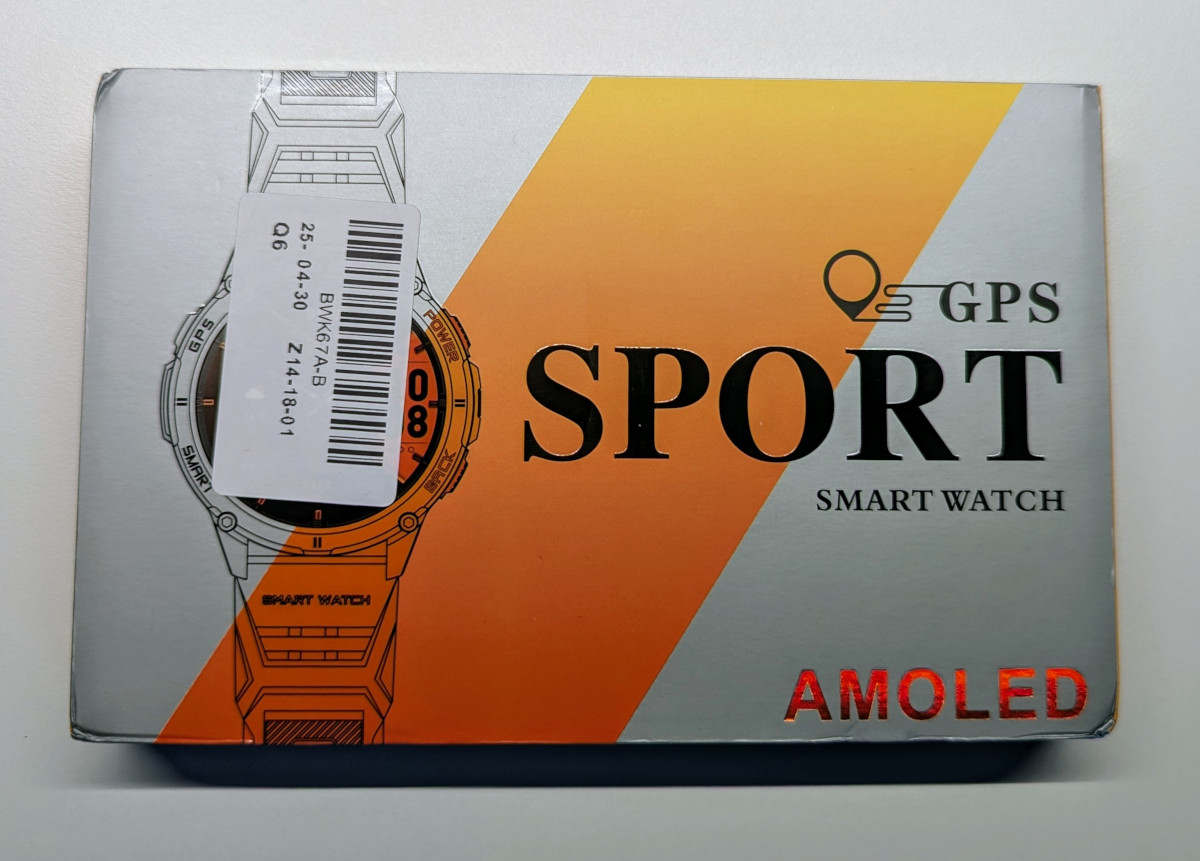
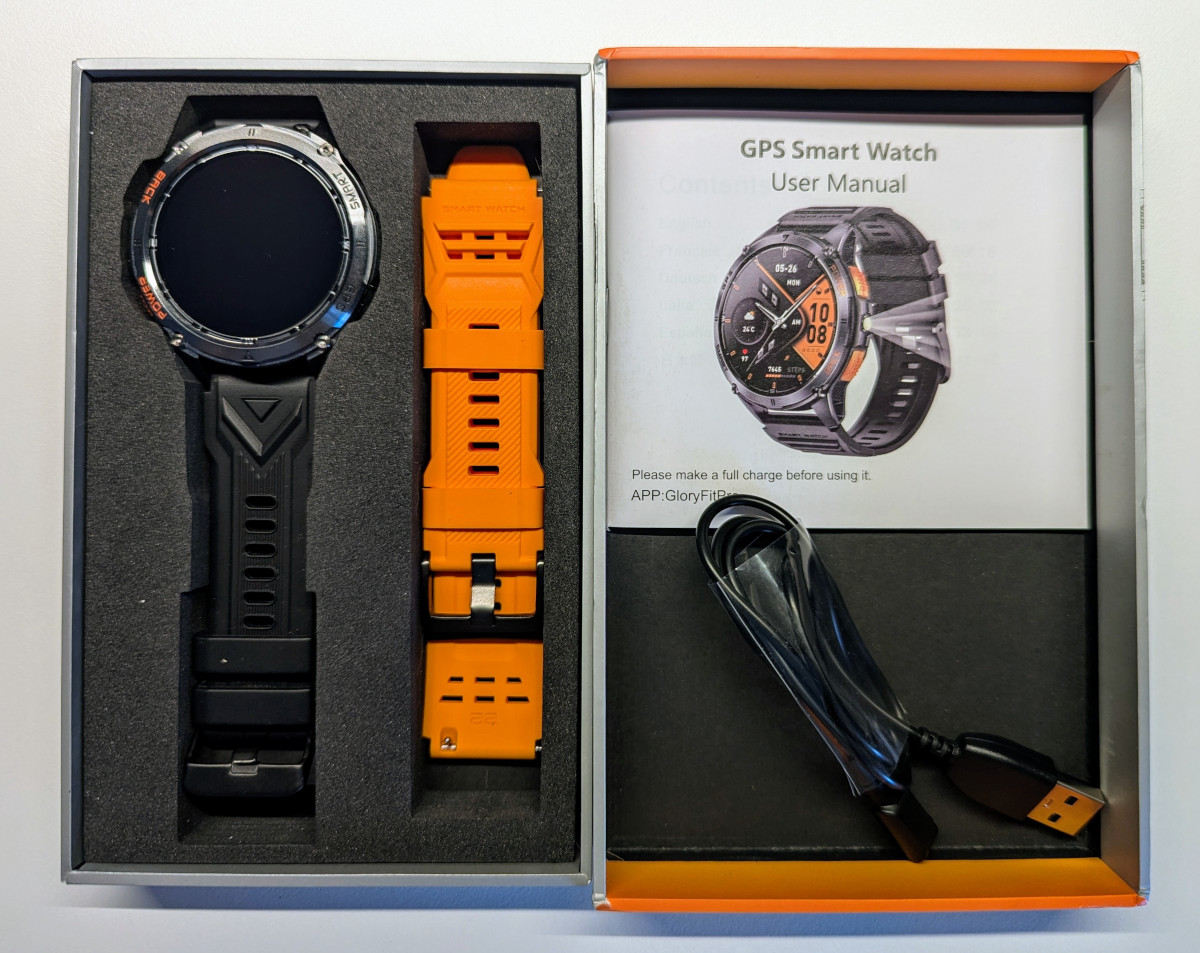
Design and Build Quality
The K67A is a very handsome zinc alloy watch with a plastic back plate. It comes in either silver or black variants (I bought the black one) with a circular, sporty design.
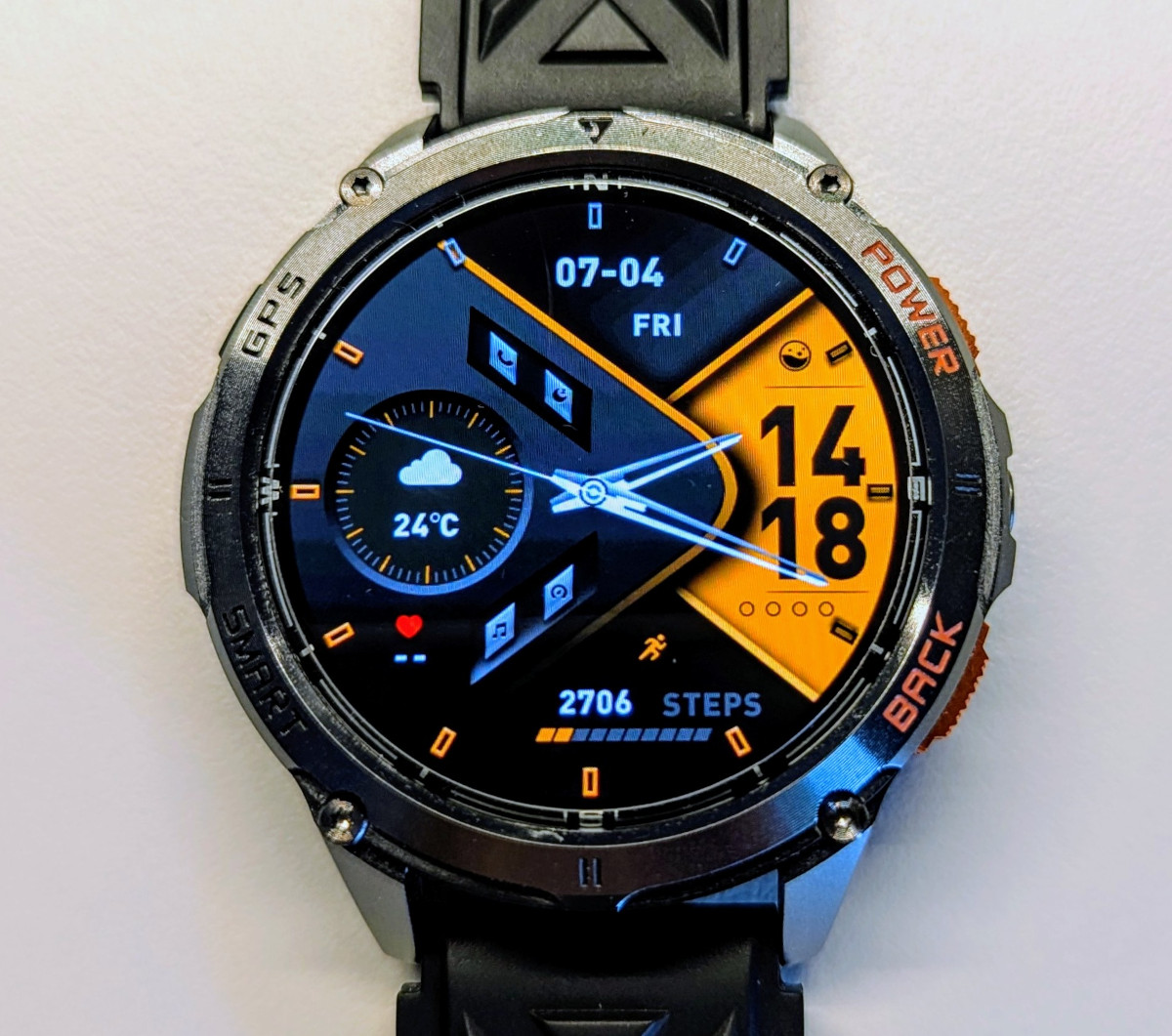
In general, the build quality of the watch is very high. It feels reassuringly solid, and the metal casing - while not being steel - is still durable. After 10 days of wearing the watch, I cannot see any scuffs or marks on it. The back is made of hard plastic, with charging pins and windows for the heart rate and SpO2 sensors.
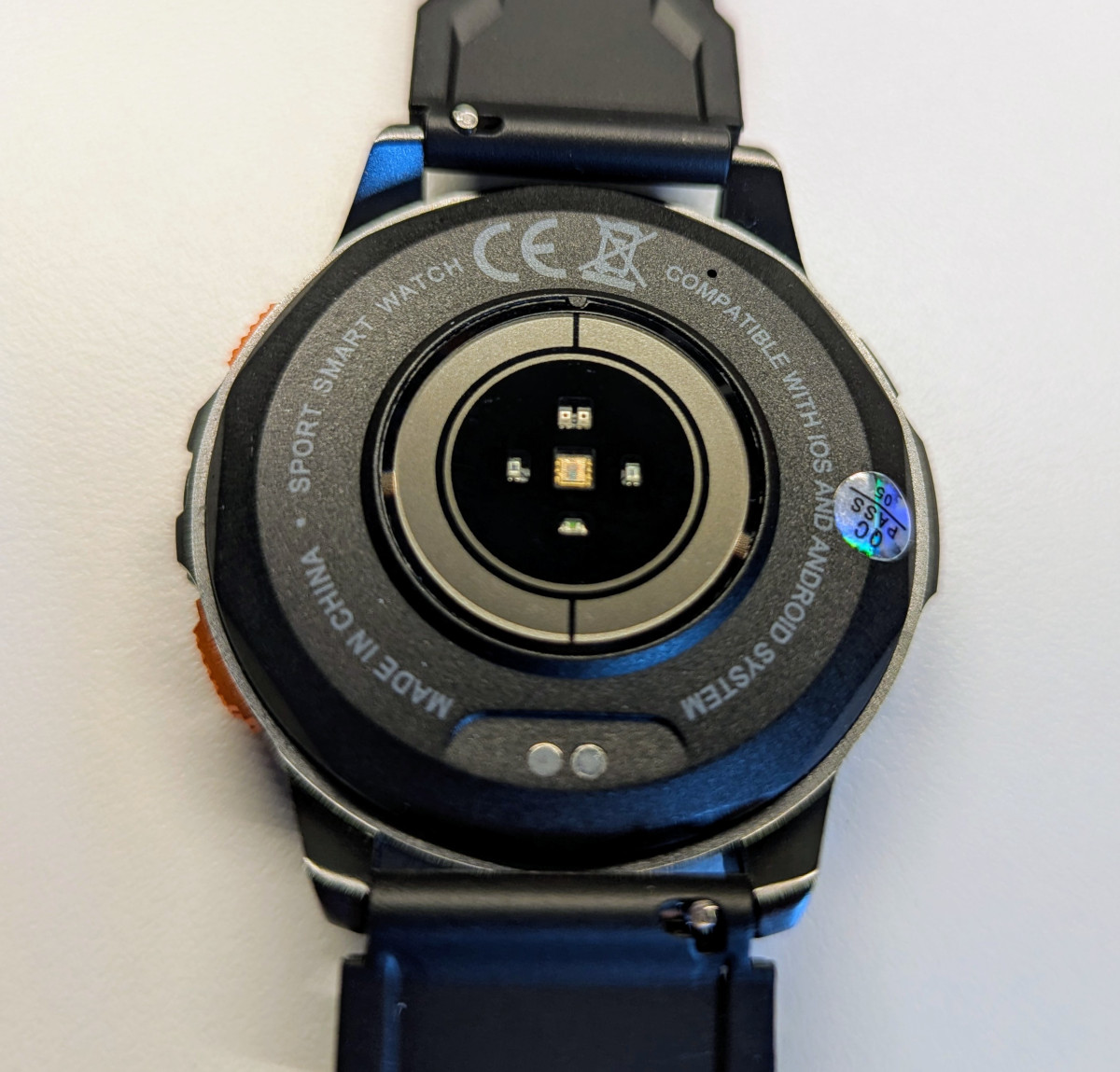
It sports a torch on the right-hand side. It’s not particularly bright - especially not compared to other watches like the KT80 - but it’s still really useful and bright enough to use in a pinch. The positioning is unfortunate, though, as your hand blocks about half the beam.
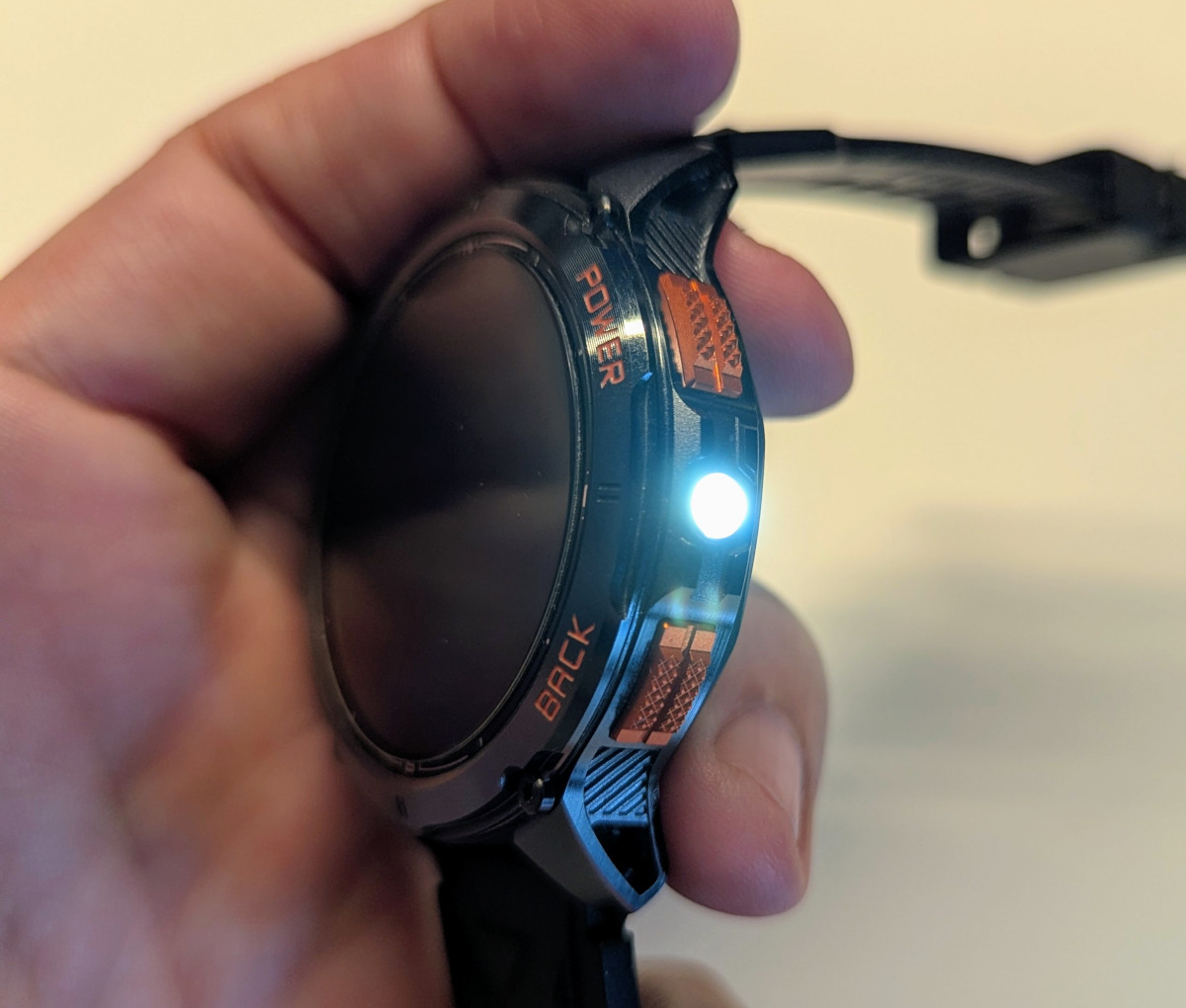
Three physical buttons provide access to menus and power:
-
Top right: power button when long-pressed, back to watch face, and when on the watch face, it turns the screen off. Opens the apps menu.
-
Bottom right: back button when outside of the watch face, a configurable shortcut when on it, and long press opens the voice assistant app.
-
Top left: shortcut to the workouts app (top left).
Unfortunately, the configurable shortcut cannot be configured to turn the torch on and off - you can make it point to the torch app, but you still need to tap the screen to actually operate the light. This seems like it could’ve easily been fixed in software.
Display
The 1.43-inch AMOLED display is bright and vibrant, with good visibility even in direct sunlight thanks to its 600-nit brightness. The 466x466 resolution provides crisp text and graphics, and honestly, there’s absolutely nothing to complain about here.
The glass is unfortunately not Corning Gorilla or sapphire, which is not really a criticism and is to be expected at this price range. It is, however, recessed, so putting the watch face down should protect it from getting scratched for the most part.
Being a regular flat circular face, you’ll be able to purchase screen protectors easily. You’ll see in the images that I’ve done so - specifically, a 38mm tempered glass protector which still leaves a little room on the sides to get it off should the need arise.
AOD (Always On Display) is available and has its own little library of watch faces, but be warned as the watch’s battery life will halve.
Watch interface
The K67A uses the same watch OS as other GloryFitPro watches that sport most of the same internal hardware, like the Y101, Kospet Tank T3 Ultra 2, or Zeblaze Stratos 2. The system is intuitive and elegant, although not particularly fluid - on more complex screens like those showing heart rate graphs, the framerate is in the single digits. It’s something that doesn’t impede operation, though, but leaves me wishing the manufacturer would use the more advanced Actions ATS3085S on some of those watches - it has a more capable GPU, as shown in other watches like the Starmax GTX2 or the FT66.
Swiping around is generally OK, but there’s quite some room for improvement. I have noticed a couple of annoyances:
-
From the watch face, swiping in different directions to bring up the various parts of the interface is a bit inconsistent, and it seems like it’s best to place your finger all the way to the opposite side you want to swipe to. The cards screen also needs you to swipe down from the very top.
-
Scrolling on apps that have several screens worth of content - like the weather or heart rate apps - can be frustrating at times, as it scrolls page to page and often overshoots to the next page you really wanted to view. Again, this is something that should be fixable in software, but I haven’t received any firmware updates during the time I wore the watch to review.
Regardless, the watch’s interface is pretty standard and should be familiar to anybody who’s used a smartwatch before.
From the watch face, swiping down brings up the quick settings, which are editable. There are a lot of options and it’s genuinely useful:
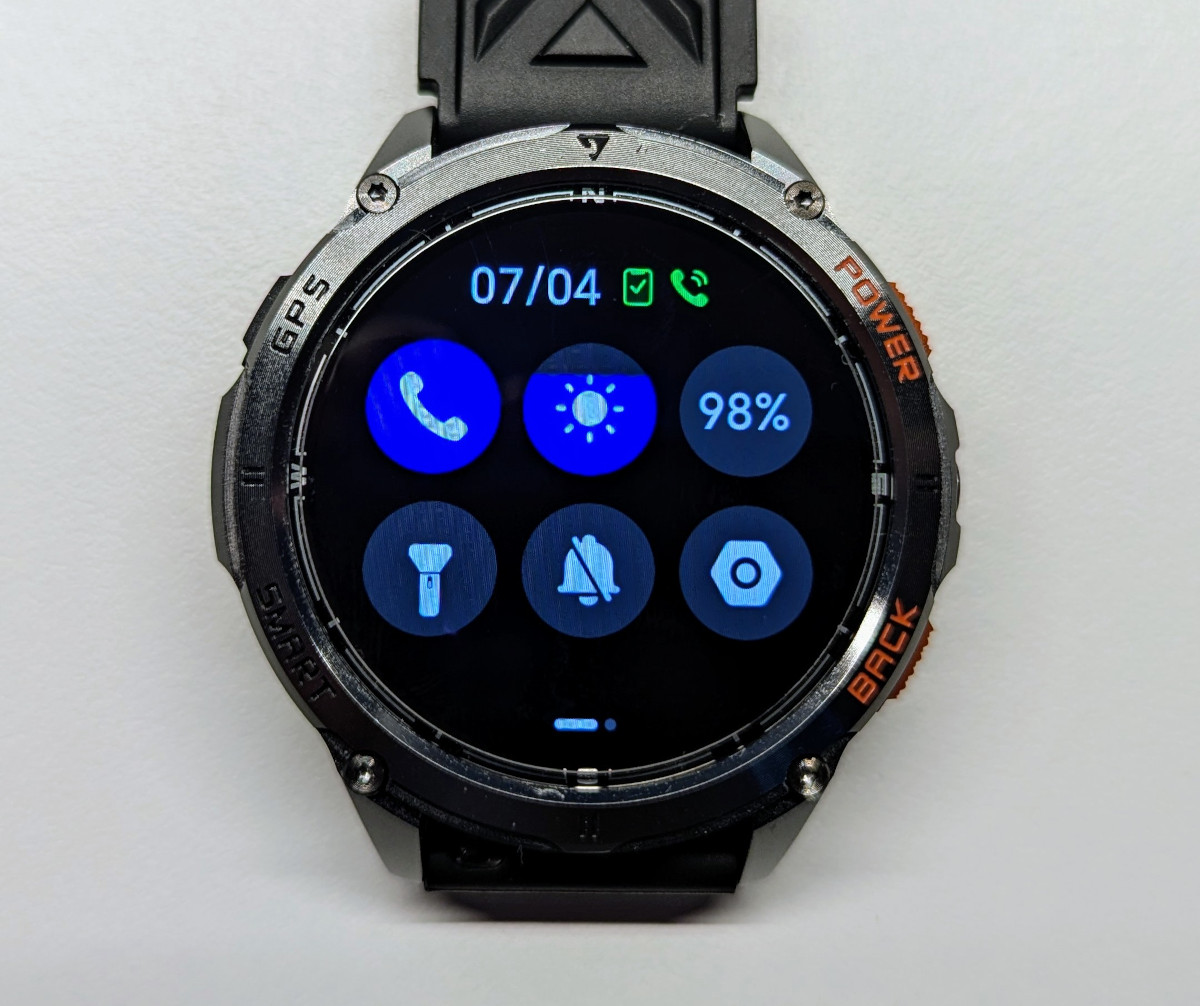

Swiping left opens the apps menu. There are several styles of menu, like icon grids and the like, but I’ve found them pretty useless, and the list menu is the one that gives you the best chance of quickly locating what you’re after - as it not only shows the app names, it shows them for all of the apps currently on screen. Unfortunately, the sorting of this menu is a bit random, and things are hard to find:
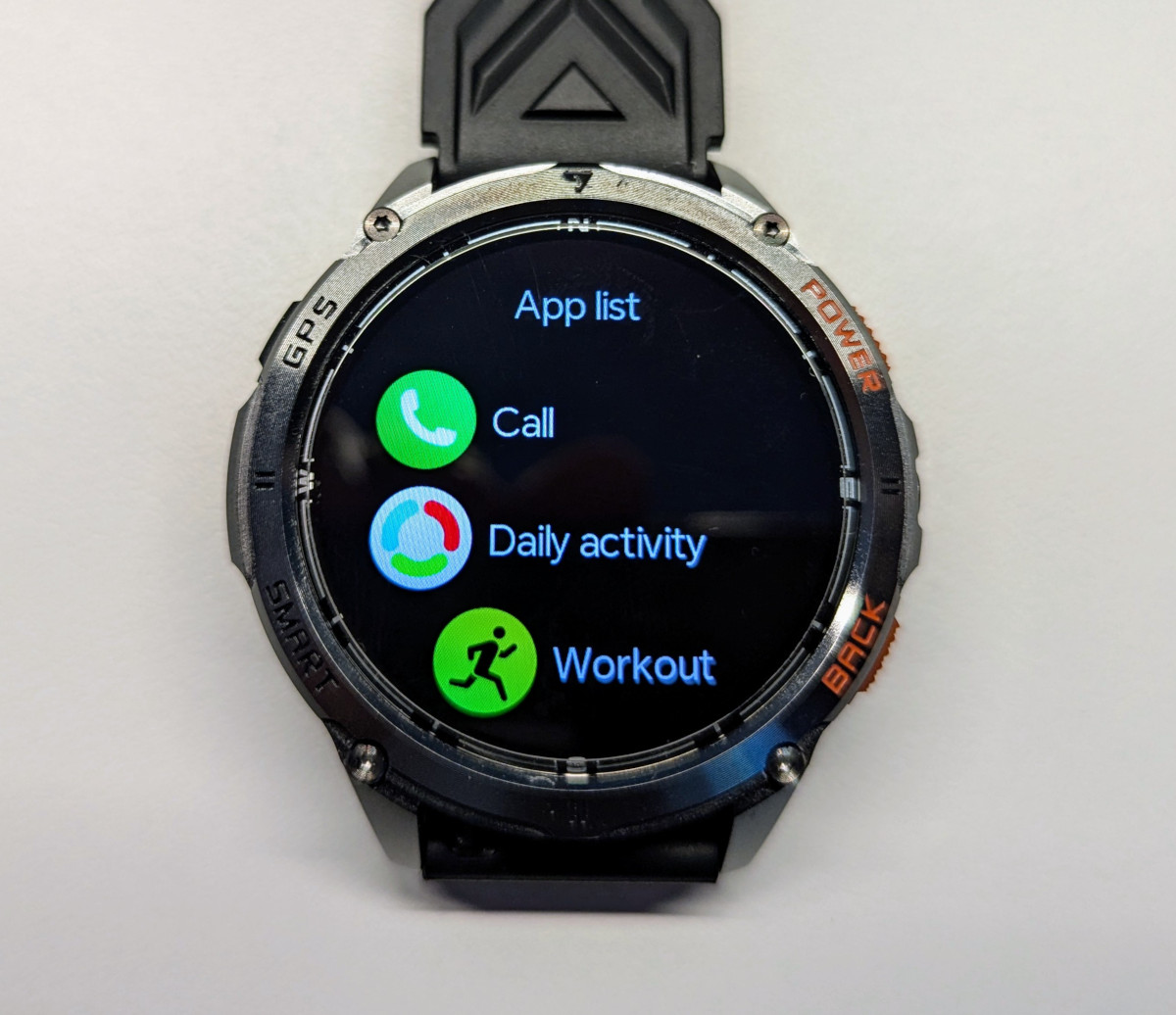
Swiping right brings up the notifications menu. Notifications are fairly simple - they mirror your phone’s notifications and nothing else. You can choose what app notifications to send to the watch on the app. However, the selection of available apps is very narrow and on my phone has some glaring omissions like Google Calendar or my banking apps. You can get around this problem with the “Notify for Smartwatches” app from the Play Store, which is selectable in GloryFitPro and in turn allows you to funnel notifications from unsupported apps.
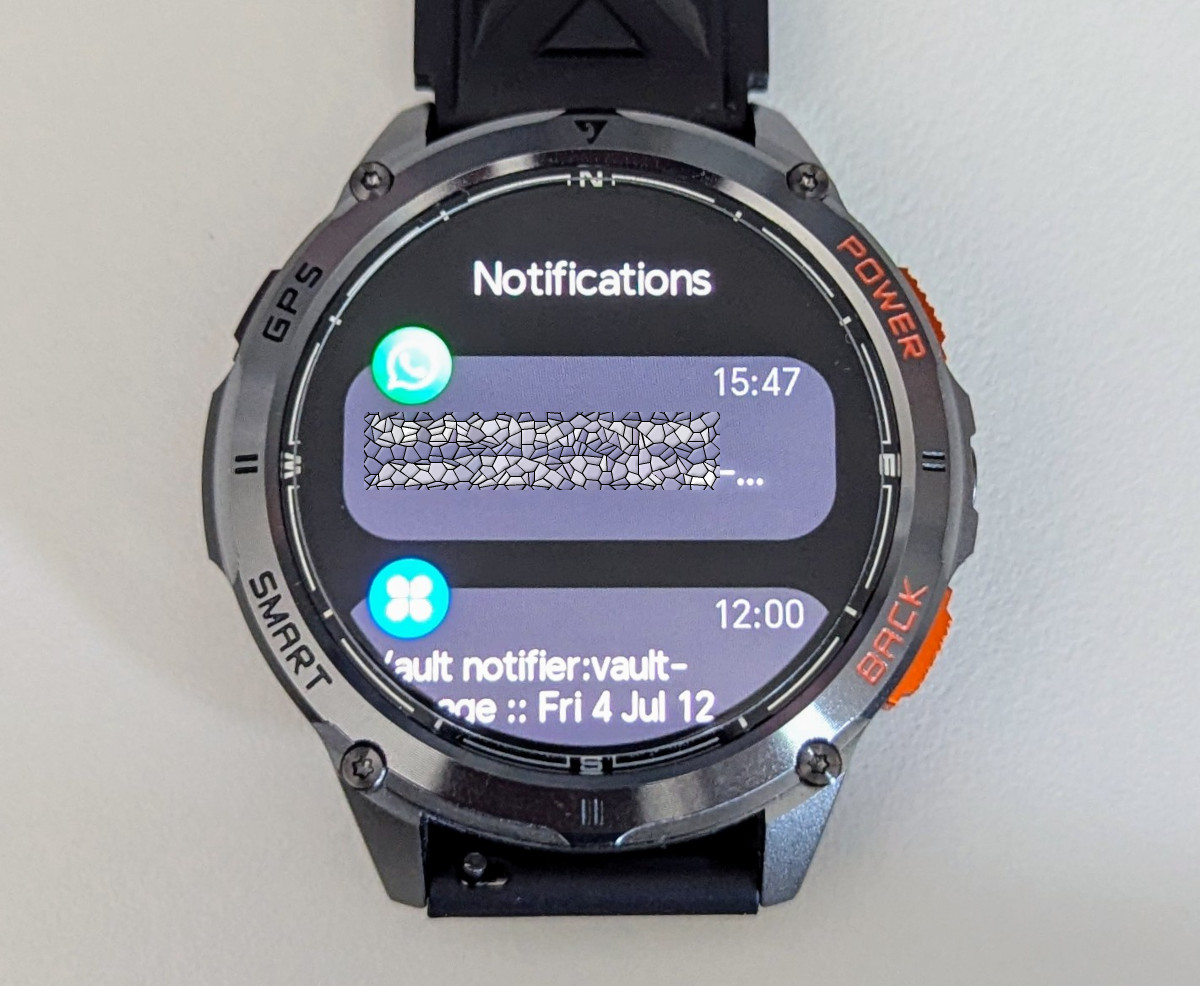
Finally, swiping up brings up the cards menu, which is a really useful feature of the watch. From here you have cards for things like your daily activity, heart rate, sleep tracking, timers, etc. It’s the best way to interface with the different apps in the watch, and it’s editable - you can remove and reorder items at to suit your needs.
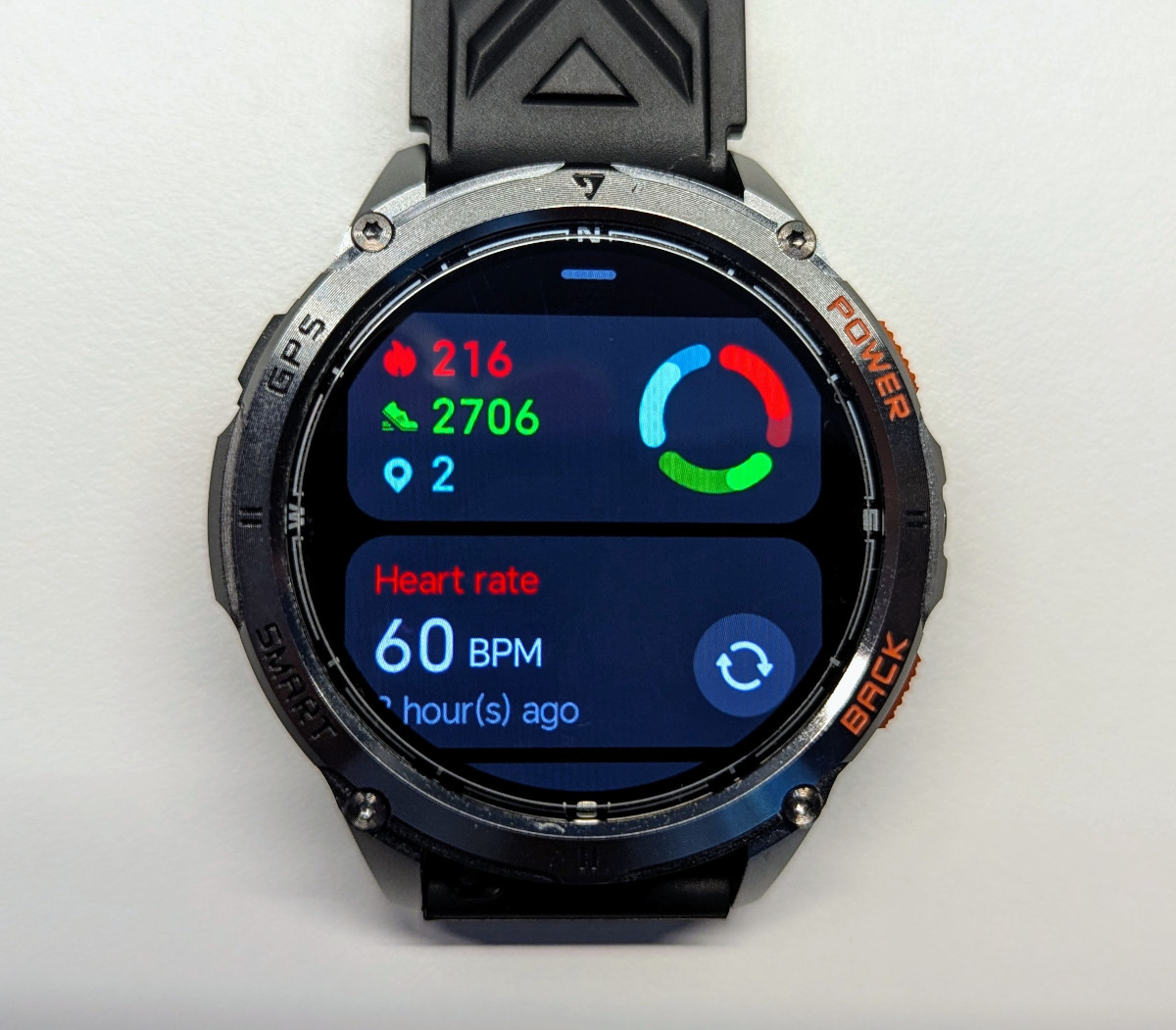
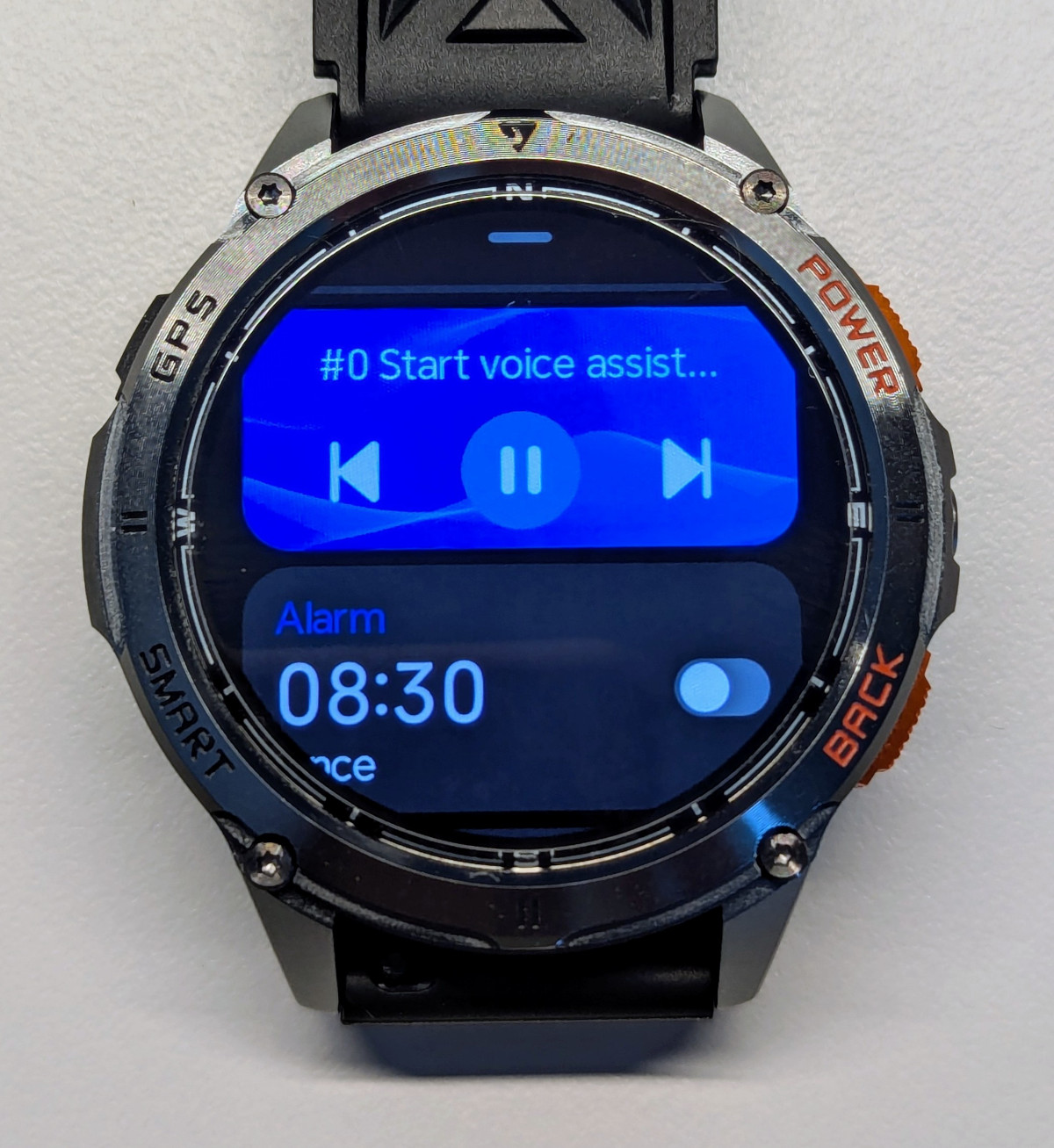
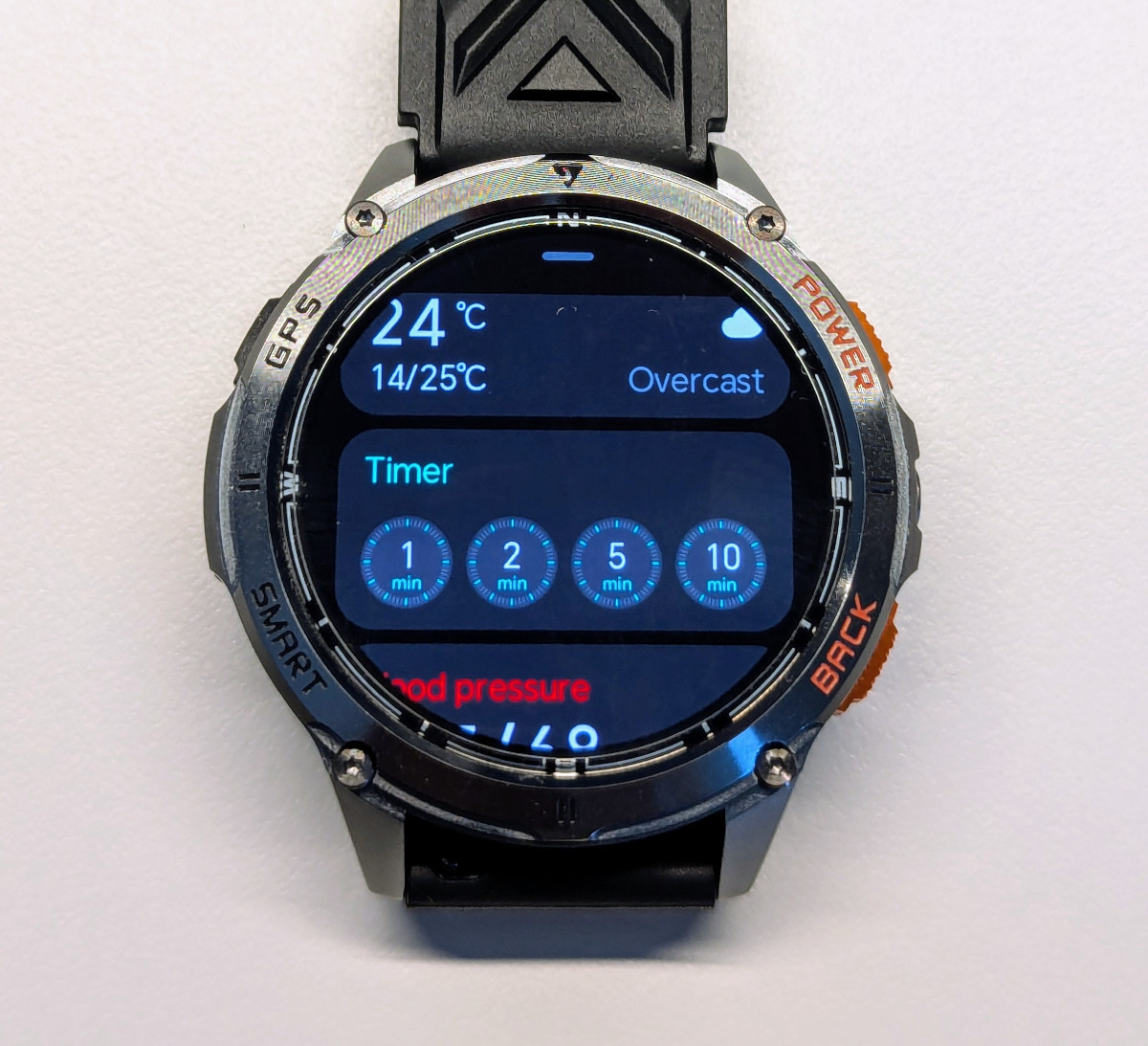
Note: some configuration options are quite hidden and not available either from the app or the watch settings, like more granular config for the heart rate monitor. You’ll configure these by going to their apps on the watch and scrolling all the way down.
Watch faces
The watch comes with 7 preinstalled watch faces that cannot be removed, some of which have actionable buttons (hard to tap, though, and barely useful), and allows you to install a further 4 from the app. The selection on the app is ample, and there are loads of good options there.

AOD has its own separate pool of watch faces - 7 preinstalled and one that can be installed from the app.

Battery Life and Charging
Battery life is where the K67A truly shines. The 530mAh battery provides up to 7 days of heavy use with raise-to-wake enabled, and up to 30 days on standby. These figures are impressive compared to other smartwatches and eliminate the daily charging anxiety that plagues most smartwatch users.
Using Always On Display, however, will bring that 7-day figure down to 3. I personally left it off and relied on raise-to-wake instead, which reacts quickly enough to be useful.
The magnetic charging cable attaches securely and charges the watch from empty to full in about 1 hour. The watch also features power-saving modes that can extend battery life even further by limiting certain features, like notifications.
Note: even though the cable is the same all these watches use, it uses a different polarity than them. Specifically, the positive pin is the one closest to the cable, and the negative pin the furthest. Bear this in mind if you ever need a replacement cable.
Health Monitoring
The K67A covers the basics of health monitoring with 24/7 heart rate tracking, blood oxygen monitoring, sleep tracking, and even blood pressure monitoring. While these features work reasonably well, they don’t match the accuracy or depth of analysis provided by Apple, Garmin, or Fitbit devices.
Heart rate and SpO2
With regards to the heart rate sensors, this watch sports the VC30F-S sensor, which is found widely in the budget segment of Chinese watches. Specifically, it seems like it’s the same heart rate sensor used across - but not limited to - all of the GloryFit and GloryFitPro watches.
Continuous heart rate monitoring, as recorded by stats and the app, is done on a schedule, which is somewhat configurable (5, 10, 20 minutes…), and the heart rate sensor will also wake up when the screen is woken up to take live readings until the screen goes off.
The sensor on this watch - or the software governing it - is unfortunately rather buggy. It has a very serious cold boot issue whereby the sensor records what looks like double the heart rate when it wakes up from being off, and continues to do so until it shuts down again. This completely messes up the heart rate monitoring, as your readings will appear ridiculously high all day long. You can see a comparison of the same 24h period with a Pixel Watch 2 via Fitbit:
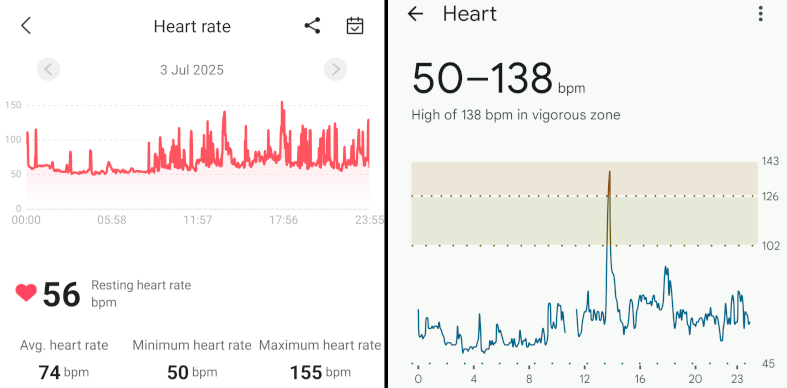
As you can see, the Pixel Watch 2 only shows a peak over the 102 bpm mark, and it was during a 15-minute elliptical workout. The rest of the day shows my heart rate to be around the 55–75 range, which is my usual light activity heart rate. The K67A, however, recorded many peaks well above that range and punching far into the 120 bpm range. Unfortunately, this issue also manifests during workouts, which tends to skew the workout stats.
The issue may or may not be related to the watch’s movement, as often during sleep the readings look (mostly) normal. Wearing the watch pretty tight, however, makes no difference to the reliability of the readings.
Sleep tracking
I found sleep tracking to be surprisingly accurate compared to my Pixel Watch 2. The watch was able to successfully detect my sleep and wake-up times, as well as provide a reasonable ballpark of the different sleep stages. The only part it seemed to struggle with was recognising short wake-up moments during the night. Very pleasantly surprised in this regard.
![]()
![]()
Blood pressure
I don’t understand why manufacturers insist on including fake features on what’s basically a legit budget watch. Blood pressure can’t be derived using a heart rate sensor - let alone a budget one - and as such, those readings are probably just random.
Stress
Not much to say about this. It measures your heart rate, then gives you a stress score. It seems to be reasonably accurate when the heart rate sensor was working properly, but I found its usefulness to be rather limited - more of a curiosity.
Fitness and Outdoor Features
The K67A supports multiple sports modes, covering everything from running and cycling to more niche activities. The GPS with AGPS provides reliable tracking in most environments, though it’s not quite as precise as the multi-band GPS systems found in premium watches. In my workouts, however, I found the GPS to reliably track my routes with very little wobble. Here’s an example of a recent outdoor walk:

When it comes to stats like distances, calorie burns, steps, and heart rates, I found it to be reasonably close to my reference Pixel Watch 2, which is one of the best watches on the market for this. The GloryFitPro app and watch OS system have really been polished from the earlier GloryFit system, and you can tell a lot of effort has been put into the number crunching that goes into generating those stats. Here’s an outdoor walk taken on both the K67A and the Pixel Watch 2:
![]()
I’ve tracked a number of other activities like indoor walking, elliptical, and strength training, and the results have been similar.
Unfortunately, the unreliable nature of the heart rate monitoring system means that some workouts have bad heart rate monitoring data for some or all of the duration, which skews not just the heart rate stats but also the calorie burn. If it weren’t for this, I would have no qualms about using this watch to track my workouts on a daily basis.
These are the heart rate graphs of the same 93-minute outdoor walk on both the Pixel Watch 2 and K67A:
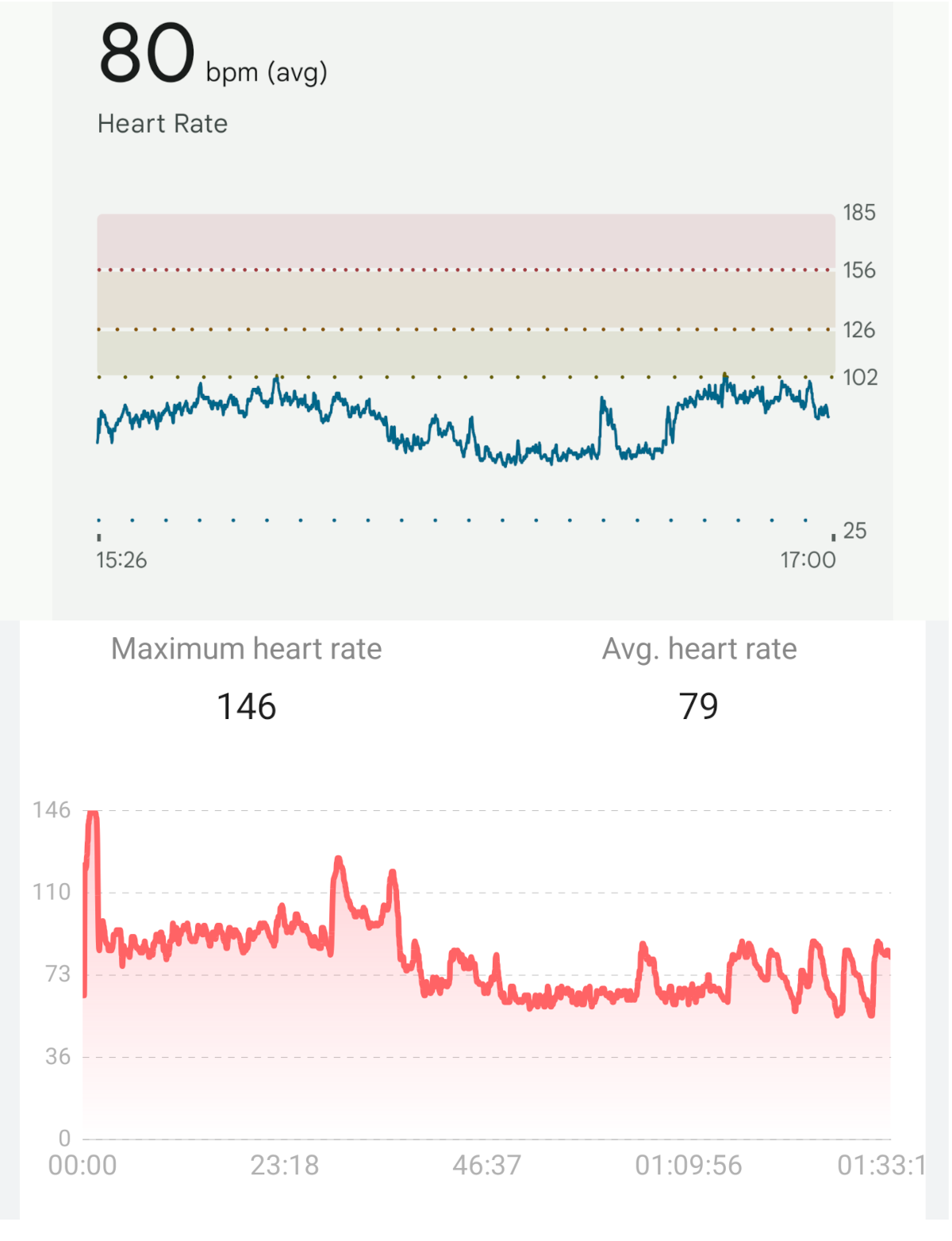
As you can see, the watch initially started registering double the heart rate until I reset the sensor by taking it off my wrist, then again about 20 minutes in. The last portion also has issues where it underestimates heart rate. Elsewhere in the graph, it’s a pretty close match.
Smartwatch Features
As a smartwatch, the K67A offers notification mirroring, music control, weather updates, and a handful of basic apps. The notification system works well enough, displaying messages and alerts from your phone, though interaction options are limited.
Some of them:
-
Notifications / messages: these watches don’t truly allow you to read your messages. Instead, they mirror your notifications and are thus limited by what they show. Notifications are grouped by app and they work well enough, but there are some glaring omissions on the list of apps that can be whitelisted, like Google Calendar. The “Notify for Smartwatches” app on the Play Store can help with this.
-
Alarms: they can be created in-watch and work reliably.
-
Timers: timers can be left in the background without being discarded and also work well enough, but they only vibrate for some reason. But they vibrate for quite a while, so they’re hard to miss.
-
Bluetooth calling: no issues here. The speaker and microphone work really well. Callers could hear me and I could hear them just fine. Worked impeccably.
-
Weather: the weather app is the best of the budget watches I’ve tried so far. It gives the current conditions, a 12-hour forecast, and a 7-day forecast, and all of that is displayed impeccably and is easy to read. Nothing to complain about here other than the scrolling issue mentioned earlier.
-
Find my phone / watch: works fine both ways.
The app: GloryFitPro
In my usage, I found the connection to the app to be stable without dropouts. Notifications would arrive in some cases even before on my reference Pixel Watch 2.
The app itself is very nicely laid out. Daily monitoring features like heart rate and SpO2 are easily accessible and displayed with relevant data and nice-looking graphs - which can’t be zoomed into but do provide reading values and timestamps when tapped.
Workout records were, however, a bit unclear to get to - you can’t see a list of workouts and then choose which one to look at. Instead, you go to the Sports tab, look for the tab corresponding to the type of workout (e.g., Outdoor Walk), which looks simply like a screen where you start a new activity, then tap on whatever stat is highlighted at the very top (e.g., Cumulative consumption (kcal) on strength training).
Conclusion
The K67A occupies an interesting middle ground in the smartwatch market. It can’t match the sophisticated health tracking, app ecosystem, or refined user experience of premium smartwatches, but it offers good durability and battery life at a much more accessible price point.
The one thing that unfortunately lets the watch down is the buggy heart rate monitoring. It pollutes your daily monitoring data with bad readings and your workouts with bad stats. I’m not sure if this is an issue of the K67A, the review unit I had, the VC30F-S sensor itself, or a bug in its governing software. It’s a real shame, as I found activity tracking to be exceptionally good considering this is a budget smartwatch - but it did ruin the stats on quite a few of them.
For outdoor enthusiasts who prioritize ruggedness and battery longevity over smart features, or for those working in harsh environments where a delicate smartwatch would quickly succumb, the K67A represents excellent value. It’s also a compelling option for those who simply don’t want to charge their watch every day.